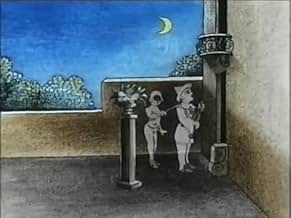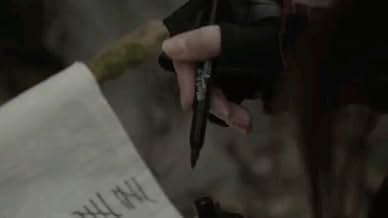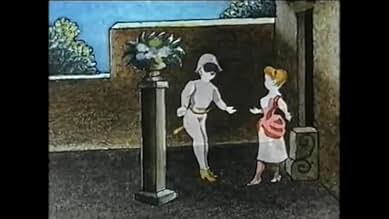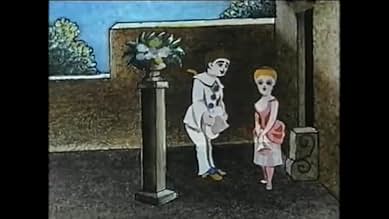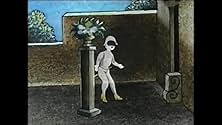VALUTAZIONE IMDb
6,5/10
2214
LA TUA VALUTAZIONE
Il romantico Pierrot visita di notte la sua amata Colombina, ignaro che il furbo Arlecchino lo sta spiando. Mentre Pierrot cerca di conquistarla con il suo affetto, Arlecchino lo spaventa, f... Leggi tuttoIl romantico Pierrot visita di notte la sua amata Colombina, ignaro che il furbo Arlecchino lo sta spiando. Mentre Pierrot cerca di conquistarla con il suo affetto, Arlecchino lo spaventa, facendolo fuggire.Il romantico Pierrot visita di notte la sua amata Colombina, ignaro che il furbo Arlecchino lo sta spiando. Mentre Pierrot cerca di conquistarla con il suo affetto, Arlecchino lo spaventa, facendolo fuggire.
- Regia
- Sceneggiatura
Recensioni in evidenza
"Pauvre Pierrot" is apparently the first animated film and you probably want to read IMDB's trivia section on how the film was made. All I know is that the copy floating about YouTube is gorgeous and looks nothing like you'd expect a film that is 127 years old!
The story is very simple...something I'd expect from 1892 since films were just invented and complex stories were still not made for several years to come. The animation is very jerky (due to a low cel count) but speeding up the film could correct this...so if you find a copy and play it on Media Player Classic (for example), you can double the speed and it would look better.
As for the story, it's very, very simple and involves the classic Commedia dell'arte character, Pierrot, moving about on the screen with a girl. Not exactly thrilling today...but remember...it was 1892 and for that time, this is a really amazing piece of art.
The story is very simple...something I'd expect from 1892 since films were just invented and complex stories were still not made for several years to come. The animation is very jerky (due to a low cel count) but speeding up the film could correct this...so if you find a copy and play it on Media Player Classic (for example), you can double the speed and it would look better.
As for the story, it's very, very simple and involves the classic Commedia dell'arte character, Pierrot, moving about on the screen with a girl. Not exactly thrilling today...but remember...it was 1892 and for that time, this is a really amazing piece of art.
This is a very, very, very, very impressive movie for 1892. Yes, 1892! Edison was still experimenting with his Kinetoscope in America, Etienne-Jules Marey was using his Chronophotographic Gun to shoot film experiments, and films were, like, 3 seconds! Charles-Emile Reynaud's "Pauve Pierrot" originally ran 15 minutes, is in painted color by Reynaud himself, and (drum-roll, please) is animated! 1892, and this is the first cartoon! It consists of 500 images, tells a story, and is something you'd think came much, much later than this!
That's not to say it doesn't have any flaws. It definitely does. For one thing, while this is animation, it is very, very primitive looking by today's standards. The figures' movements are jerky, and at times they don't move at all. One particularly poorly animated spot is when Colombine comes out to meet Harlequin, as well as when she opens the door for Pierrot. Also, while sometimes there is some cutting closer to the figures, we mostly view what's going on from a single vantage point. If you decide to see this, bear in mind that, while ground-breaking, the animation isn't anything like what you'd see nowadays.
It's so sad. So much of Reynaud's work is lost today. The only other available cartoon from him is "Autour d'un Cabine" from 1894. His other two cartoons, "Le Clown et ses Chiens" and "Un Bon Bock" were both thrown into the Seine by Reynaud himself. Luckily, he spared these two movies so they could be seen and appreciated today.
That's not to say it doesn't have any flaws. It definitely does. For one thing, while this is animation, it is very, very primitive looking by today's standards. The figures' movements are jerky, and at times they don't move at all. One particularly poorly animated spot is when Colombine comes out to meet Harlequin, as well as when she opens the door for Pierrot. Also, while sometimes there is some cutting closer to the figures, we mostly view what's going on from a single vantage point. If you decide to see this, bear in mind that, while ground-breaking, the animation isn't anything like what you'd see nowadays.
It's so sad. So much of Reynaud's work is lost today. The only other available cartoon from him is "Autour d'un Cabine" from 1894. His other two cartoons, "Le Clown et ses Chiens" and "Un Bon Bock" were both thrown into the Seine by Reynaud himself. Luckily, he spared these two movies so they could be seen and appreciated today.
It's cheating a little to list this as a film as strictly speaking it's not one, though its maker Émile Reynaud pushed pre-cinema technology as far as it could go to achieve an experience practically indistinguishable from that of watching a theatrical presentation of an animated cartoon film. His Théâtre Optique featured his Praxinoscope, a radical development of old-established animation toys like the Zoetrope. This used rotating faceted mirrors and lenses that could project a succession of hand-drawn images from a paper strip with sprocket holes, allowing much longer sequences of continuous action than the short loops hitherto used in such devices. These images were then superimposed on a static background projected from a conventional magic lantern slide, prefiguring later cel animation techniques in which the image is broken down into a succession of layers with the minimum of movement in each one. The exhibition was completed with live narration and music.
Some of Reynaud's original elements survive (others he later threw in the Seine) and their affinity with film is demonstrated by the ease with which they can be reconstructed on modern film or video. Pauvre Pierrot was the first such production and is among the most charming, a simple tale featuring the traditional characters Pierrot, Arlequin and Colombine acting out their ancient love triangle. Some reconstructions replicate the translucent, slightly ghostly quality the characters would have had at the time. Sadly Reynaud's work was overtaken by the arrival of the cinema proper and he died a poor and unhappy man.
Some of Reynaud's original elements survive (others he later threw in the Seine) and their affinity with film is demonstrated by the ease with which they can be reconstructed on modern film or video. Pauvre Pierrot was the first such production and is among the most charming, a simple tale featuring the traditional characters Pierrot, Arlequin and Colombine acting out their ancient love triangle. Some reconstructions replicate the translucent, slightly ghostly quality the characters would have had at the time. Sadly Reynaud's work was overtaken by the arrival of the cinema proper and he died a poor and unhappy man.
Pauvre Pierrot, directed by Charles-Émile Reynaud, is one of the first animated films ever made. It is made up of 500 individually painted images and originally lasted about 15 minutes. The version available to today is a 4 minute version, restored from pieces of the original.
It's a simple story of a woman with two men wooing her, one she cares for, and the other which is somewhat a nuisance to her, even if he is sincere. To achieve his effects, Reynaud invented his Théâtre-Optique system which was basically a zoetrope with a projector. The images showed successive images of moving figures in front of blackbackgrounds. These images could be adjusted in real-time to project tthe animated characters against an immobile background image which was being projected by a second projector from a painted glass plate.
At times the show was quite elaborate. Original music and songs were written for the show, played by an piano accompanyist and sung by an actor. Reynaud performed 12,800 shows from 1892 to 1900. Commercially successful for a time, the popularity of these shows were eventually overtaken by the projected camera live action films of the Lumières and others.
It's a simple story of a woman with two men wooing her, one she cares for, and the other which is somewhat a nuisance to her, even if he is sincere. To achieve his effects, Reynaud invented his Théâtre-Optique system which was basically a zoetrope with a projector. The images showed successive images of moving figures in front of blackbackgrounds. These images could be adjusted in real-time to project tthe animated characters against an immobile background image which was being projected by a second projector from a painted glass plate.
At times the show was quite elaborate. Original music and songs were written for the show, played by an piano accompanyist and sung by an actor. Reynaud performed 12,800 shows from 1892 to 1900. Commercially successful for a time, the popularity of these shows were eventually overtaken by the projected camera live action films of the Lumières and others.
It is said that Pauvre Pierrot (1892) was the first animated film ever (it was presented with Le Clown et ses chiens (1892) and Un bon bock (1892)). Was exhibited in October 1892 when Charles-Émile Reynaud opened his Théâtre Optique at the Musée Grévin. It is probably the first usage of film perforations. Pauvre Pierrot originally consisted of 500 individually painted images, which originally was 15 minutes long, but the 1996 restoration made it 4 minutes long.
The story is about Harlequin (best-known of the zanni or comic servant characters from the Italian Commedia dell'arte), Colombina (a stock character in the Commedia dell'Arte, she is Harlequin's mistress, a comic servant playing the tricky slave type and wife of Pierrot) and Pierrot (is a stock character of pantomime and Commedia dell'Arte). It is a comedy, though nowadays it isn't that funny, in its time it must have been one of the funniest things that existed. I wish I was there when it happened.
The story is about Harlequin (best-known of the zanni or comic servant characters from the Italian Commedia dell'arte), Colombina (a stock character in the Commedia dell'Arte, she is Harlequin's mistress, a comic servant playing the tricky slave type and wife of Pierrot) and Pierrot (is a stock character of pantomime and Commedia dell'Arte). It is a comedy, though nowadays it isn't that funny, in its time it must have been one of the funniest things that existed. I wish I was there when it happened.
Lo sapevi?
- QuizThe cartoon was hand drawn on hundreds of sheets of glass, each inlaid in a leather strips, through which a light was shone projecting the figures on a backdrop, as it was spooled from one reel to another, much like a modern film reel.
- ConnessioniFeatured in La magie Méliès (2002)
I più visti
Accedi per valutare e creare un elenco di titoli salvati per ottenere consigli personalizzati
Dettagli
- Data di uscita
- Paese di origine
- Lingua
- Celebre anche come
- Poor Pierrot
- Vedi altri crediti dell’azienda su IMDbPro
- Tempo di esecuzione5 minuti
- Mix di suoni
Contribuisci a questa pagina
Suggerisci una modifica o aggiungi i contenuti mancanti

Divario superiore
By what name was Pauvre Pierrot (1892) officially released in Canada in English?
Rispondi
